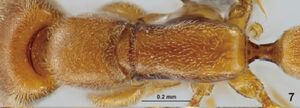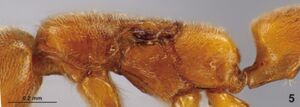Xymmer phungi
| Xymmer phungi | |
|---|---|

| |
| Scientific classification | |
| Kingdom: | Animalia |
| Phylum: | Arthropoda |
| Class: | Insecta |
| Order: | Hymenoptera |
| Family: | Formicidae |
| Subfamily: | Amblyoponinae |
| Tribe: | Amblyoponini |
| Genus: | Xymmer |
| Species: | X. phungi |
| Binomial name | |
| Xymmer phungi Satria, Sasaki, Bui, Oguri, Syoji, Fisher, Yamane & Eguchi, 2016 | |
This first Oriental species of the genus, the type colony was found nesting under a wood fragment in a lowland evergreen forest.
Identification
Satria et al. (2016) - The worker of Xymmer phungi is morphologically quite similar to that of Xymmer muticus. However, the former is distinguishable from the latter by the following two characteristics of the worker: clypeal lobe 1/6 times as long as broad (vs. 1/3 times as long as broad in X. muticus); anterior margin of the lobe weakly concave (vs. almost straight in X. muticus).
Distribution
Latitudinal Distribution Pattern
Latitudinal Range: 18.276944° to 18.276944°.
| North Temperate |
North Subtropical |
Tropical | South Subtropical |
South Temperate |
- Source: AntMaps
Distribution based on Regional Taxon Lists
Oriental Region: Vietnam (type locality).
Distribution based on AntMaps
Distribution based on AntWeb specimens
Check data from AntWeb
Countries Occupied
| Number of countries occupied by this species based on AntWiki Regional Taxon Lists. In general, fewer countries occupied indicates a narrower range, while more countries indicates a more widespread species. |

|
Estimated Abundance
| Relative abundance based on number of AntMaps records per species (this species within the purple bar). Fewer records (to the left) indicates a less abundant/encountered species while more records (to the right) indicates more abundant/encountered species. |

|
Biology
Satria et al. (2016) - The type series (colony Eg20iii15-01) was collected from a lowland evergreen forest at the northern end of the Trung Son Mountains. The colony nested under a wood fragment on the forest floor beside a trail on a steep slope. By sifting the nesting site, 132 workers, a dealate queen, and 46 larvae were obtained. The majority of the adults in the colony were probably captured successfully; on the other hand, many larvae were probably overlooked. Workers ran very fast on and under debris of litter and soil fallen on the bottom of a white pan. The majority (but not all) of the larvae were about the same size, suggesting the development of larvae is synchronized.
We reared a small colony fragment (consisting of 10 workers and 27 larvae) for 7 days in a small plastic case with its bottom covered thinly by soil. A weak vibration triggered workers to start migration. Larvae were transported by workers in a fixed posture: the neck of a larva was grasped by a worker and the slender body of the larva was stretched under the body of the worker along the body axis. By referring to Masuko (1990, 1993), who found Stigmatomma silvestrii and Leptanilla japonica to be specialized predators of geophilid centipedes, we placed weakened small geophilids (ca. 20 mm in length) on the ground near the aggregation site of the colony fragment. The colony moved away from the site. However, after placing the rearing container in a dark place for several hours, we found the workers assembled around the geophilids, and the larvae were placed on or beside the body of the geophilids. We observed the same phenomenon a total of two times, showing that the species can feed on geophilids, but the degree of specialization on geophilids remains unknown.
Castes
Worker
    
| |
| . | |
Queen
  
| |
| . | |
Nomenclature
The following information is derived from Barry Bolton's Online Catalogue of the Ants of the World.
- phungi. Xymmer phungi Satria, Sasaki, Bui, et al. 2016: 143, figs. 1-11 (w.q.) VIETNAM.
- Type-material: holotype worker, 15 paratype workers, 1 paratype queen.
- Type-locality: holotype: Vietnam: Ha Tinh, Vu Quang Nat. Park, TK 189, 18°16’36-38’’N, 105°22’06-13’’E, 20.iii.2015, Eg20iii15-01, IMG20160228-1 (K. Eguchi); paratypes with same data..
- Type-depositories: IEHV (holotype); IEHV, KEPC, MCZC, VNMN (paratypes).
- Distribution: Vietnam.
Unless otherwise noted the text for the remainder of this section is reported from the publication that includes the original description.
Description
Worker
Monomorphic. Head in full-face view subrectangular, with posterior margin weakly concave, in lateral view relatively flattened dorsoventrally; vertex without median furrow; anterolateral corner of head beside each mandibular insertion not forming a tooth; preoccipital carina weakly present dorsally and laterally; frontal lobe narrowly separated by posteromedian portion of clypeus; frontal carina and antennal scrobe absent; anteromedian part of clypeus produced as a short rectangular lobe (hereafter referred to as “clypeal lobe”) which is 1/6 as long as broad and has a weakly concave anterior margin; the margin without a series of dents or tubercles; mandible elongate and linear; apical and preapical teeth triangular, followed by five more or less bifid teeth and then a minute denticle; both maxillary and labial palps 3-segmented (one worker dissected); antennal socket in full-face view almost concealed by frontal lobe; antenna 12-segmented; scape relatively flattened dorsoventrally; funiculus incrassate apically but not forming a distinct club; antennal segment II longer than broad; segment III to XI broader than long, terete, not flattened; apical segment (segment XII) much longer than broad, terete, not flattened, bluntly pointed apically; eye absent. Mesosoma in lateral view very weakly convex dorsally; promesonotal suture present and flexible; mesonotum in dorsal view weakly constricted; mesopleuron not subdivided into anepisternum and katepisternum by suture or furrow; metanotal groove almost entirely absent, but weakly present on the ventrolateral part of mesosoma (in front of metapleuron); metapleural gland bulla, when seen through metapleuron, bean-shaped, located at the posterolateral corner of metapleuron; the anterior margin of bulla close to or reaching the level of propodeal spiracle; junction of dorsal and posterior faces of propodeum round, without any transverse carina; posterior face of propodeum laterally without spines/carinae; orifice of propodeal spiracle round, situated around midheight of the side of mesosoma; propodeal lobe very low, in lateral view with a roundly convex posterior outline. Mid tibia without spurs; hind tibia with a reduced barbulate anterior spur and a well-developed pectinate posterior spur; pretarsal claws simple, without teeth. Petiole with a distinct anterior peduncle which has an anteroventral corner; ventrum of the petiole in lateral view with a broadly triangular prominence; petiolar node in lateral view with very weakly concave anterior and very weakly convex dorsal outlines; petiolar spiracle in lateral view located close to the junction of dorsal face of petiolar peduncle and anterior face of petiolar node; posteriormost part of petiole broadly attached to abdominal segment III, in lateral view without a free posterior face; petiole in ventral view with inverted U-shaped sulcus; petiolar sternite in ventral view recognized as a ligulate sclerite of which the anteriormost part comes into contact with the inverted U-shaped sulcus; abdominal segment III above the helcium without a free anterior face; anteroventral outline of abdominal segment III below helcium gently curved; girdling constriction between abdominal segment III and IV distinct; pygidium large, convex across; pygidium and hypopygium laterally and posteriorly without spines/tubercles; sting well developed.
Dorsum of head densely and distinctly sculptured with hair pits, but with a smooth and hairless longitudinal band on vertex and posterior part of frons; lateral and ventral faces of head, pronotum, mesonotum, and dorsum of propodeum sparsely and weakly sculptured with hair pits; mesopleuron and metapleuron finely rugose; lateral and posterior faces of propodeum almost smooth and shining; petiolar node and gaster densely and weakly sculptured with hair pits.
Body densely covered with short decumbent hairs. Clypeal lobe anterolaterally with a pair of long setae; outer surface of mandible with a single row of setae along the inner margin; posterior dorsum of petiole with several suberect hairs; tip of gaster densely growing long setae.
Whole body light brown, with antennae and legs lighter and yellowish.
Measurements and indices of the holotype: HL 0.634 mm; HW 0.528 mm; MBL 0.380 mm; SL 0.371 mm; ML 0.899 mm; PNW 0.320 mm; HFL 0.400 mm; PL 0.477 mm; PH 0.298 mm; PW 0.246 mm; A3W 0.387 mm; A4W 0.418 mm; CI 83; MBI 72; SI 70; MI 281; HFI 76; A3I 157; A4I 108.
Measurements and indices of the paratypes (n=4): HL 0.616–0.638 mm; HW 0.513–0.532 mm; MBL 0.373–0.389 mm; SL 0.362–0.374 mm; ML 0.878–0.918 mm; PNW 0.317–0.331 mm; HFL 0.391–0.402 mm; PL 0.470–0.487 mm; PH 0.291–0.308 mm; PW 0.241–0.251 mm; A3W 0.377–0.391 mm; A4W 0.410–0.423 mm; CI 83; MBI 72–74; SI 70–71; MI 275–280; HFI 75–77; A3I 156–161; A4I 107–110.
Queen
The queen is similar to the worker except for the following features: compound eye relatively well developed, situated behind midlength of side of head; ocelli present; median ocellus in full-face view located at the level of the posterior margin of compound eye; distance between median ocellus to lateral ocellus a little longer than that between lateral ocelli; compound eye consisting of ca. 25 ommatidia; mesosoma fully segmented; mesoscutum without parapsidal and notaular lines; axillae separated from the remainder part of mesoscutum by scutal suture; scuto-scutellar suture distinct; mesopleuron separated from metapleuron and lateral face of propodeum by a conspicuous groove; metanotum recognized as a transverse strip; the anteriormost portion of metapleural gland bulla reaching the level of propodeal spiracle. The area defined by three ocelli blackish brown, much darker than the rest of the body (Fig. 2).
Measurements and indices of the paratype: HL 0.595 mm; HW 0.504 mm; MBL 0.332 mm; SL 0.347 mm; ML 0.891 mm; PNW 0.305 mm; HFL 0.383 mm; PL 0.465 mm; PH 0.286 mm; PW 0.254 mm; A3W 0.418 mm; A4W 0.458 mm; CI 85; MBI 66; SI 69; MI 292; HFI 76; A3I 165; A4I 110.
Type Material
Holotype. worker [voucher: IMG20160228-1, colony: Eg20iii15-01, IEBR], Vietnam: Ha Tinh: Vu Quang National Park: TK 189, N18˚16’36–38”, E105˚22’06–13”, K. Eguchi leg., 20/III/2015. Paratypes. 15 workers, 1 dealate queens from the same colony as holotype (Entomological Collection of the Institute of Ecology and Biological Resources, Vietnam National Museum of Nature, Museum of Comparative Zoology & Katsuyuki Eguchi).
Etymology
The specific epithet is named after a Vietnamese revolutionary leader, Mr. Phan Dinh Phung, who was born in 1847 in Ha Tinh Province and led rebel armies against French colonial forces.
References
- Khachonpisitsak, S., Yamane, S., Sriwichai, P., Jaitrong, W. 2020. An updated checklist of the ants of Thailand (Hymenoptera, Formicidae). ZooKeys 998, 1–182 (doi:10.3897/zookeys.998.54902).
- Satria, R., Sasaki, O.; Bui, T. V., Oguri, E., Syoji, K., Fisher, B.L., Yamane, S. & Eguchi, K. 2016. Description of the first Oriental species of the ant genus Xymmer (Hymenoptera: Formicidae: Amblyoponinae). Zootaxa 4168:141-150 (doi:10.11646/zootaxa.4168.1.7).

